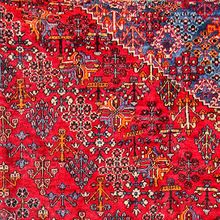Difference between revisions of "Meymeh Rug"
| Line 51: | Line 51: | ||
=== Motifs and patterns === | === Motifs and patterns === | ||
=== Weaving techniques === | === Weaving techniques === | ||
| + | The Persian (asymmetric) knot is always employed. Meymeh formats run from small mats to room-size rugs. The carpets are generally woven from very good to fine in grade quality.<ref>Moheban, 2015, p.386</ref> | ||
| + | |||
== See also == | == See also == | ||
== References == | == References == | ||
Revision as of 13:37, 24 November 2019
| Meymeh Rug | |
|---|---|
 Design of Meymeh Rug (Rugman) | |
| General information | |
| Name | Meymeh Rug |
| Original name | قالی میمه |
| Alternative name(s) | Meymeh Carpet |
| Origin | |
| Category | Village, City |
| Technical information | |
| Common designs | Vagireh, Geometric |
| Common motifs & patterns | Like to Josheghan Rug |
| Common colors | Red, Blue, Green, Ivory |
| Dyeing method | Natural, Synthetic |
| Pile material | Wool |
| Foundation material | Cotton |
| Knot type | Asymmetrical (Persian) |
Maymeh rugs are authentic hand-woven Persian rugs, made in the district of Maymeh, which is near Isfahan in central Iran. The designs are similar to Qashqai or other tribal rugs. They usually have a main diamond medallion, embedded within another medallion, embedded within another one and so on for few times. The main color is usually a rich burgundy accented with many blues, green and ivories. The quality is perhaps one of the highest among the tribal family of rugs. It is very densely knotted and will last a long time. An authentic Maymeh Persian rug is an intelligent way to greatly enhance the decor of any room.
History
Meymeh is a town in the Isfahan Province of central Iran, located on the road between KASHAN and ISFAHAN near the city of JOSHEGHAN. Meymeh rugs and carpets are known in the market from the first quarter of the twentieth century.[1]
Materials
Foundation and Pile
The carpets have a cotton foundation and a wool pile.[2]
Techniques and structures
Color and dyeing
Most Meymeh carpets have brick-red fields, but a small percentage is woven in ivory, dark blue, and other colors. These hues are interchangeable with the borders. In addition, blues, reds, greens, browns, gold, and cinnamon are woven in the design elements and outlines.[3]
Motifs and patterns
Weaving techniques
The Persian (asymmetric) knot is always employed. Meymeh formats run from small mats to room-size rugs. The carpets are generally woven from very good to fine in grade quality.[4]
See also
References
Bibliography
Abraham Levi Moheban, (2015), The Encyclopedia of Antique Carpets: Twenty-Five Centuries of Weaving, NewYork: Princeton Architectural Press.